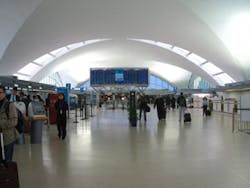Addressable fire alarm control panels fit neatly inside the trend to provide more proactive assessment of life safety detection at the protected premises. What’s more, addressable technology provides control logic that makes these systems more intuitive as well as easier to install, program, service and maintain.
Fire Alarm Control Panels (FACPs) may also include IP communicators, using the Internet and a Web-based browser to upload and download information, check programming and perform software and system updates, diagnostics and remote device control and supervision. Many central stations in the alarm industry have the receiving equipment to accept IP alarms for fire alarm signaling and the Authority Having Jurisdiction continues to recognize this type of communications. (Type this in your browser for a list of industry central stations that accept IP fire signals--http://www.firelite.com/marketing/FireWatch-IP-09_handout_Layout%201.pdf.)
Addressable in action
Tech Electronics Inc., St. Louis, won an ongoing, multi-year contract at the Lambert-St. Louis International Airport to take the facility from conventional to addressable fire alarm technology. The company initially installed two intelligent fire alarm control systems networked over a fiber optic infrastructure. Since then it has been providing ongoing service and maintenance and has added to the fire system along the way to make it nearly airport wide.
Chris A. Wilhelm, director, Construction Business Unit, Tech Electronics Inc., said addressable technology allows maintenance, service and status evolution of a panel to be kept within a controlled environment. “You really need an addressable fire alarm system to pinpoint the alarm and control the evolution of the system—with addressable you know its ‘DNA’ so to speak and what’s going on with the system and the detectors,” Wilhelm said. For example, detectors are regularly assessed and evaluated on their propensity to detect an alarm and when that measurement changes, maintenance may be necessary.
The initial network at the airport consisted of five nodes and now it boasts over 40. There are five PC-based workstations—one at each of three firehouses, one in the communication center and another for Tech Electronics to perform troubleshooting and inspection/maintenance on site. The workstations have a graphical layout of the airport and when a device goes into trouble or alarm the image zooms in to show the exact device and mapped location. When a contractor is working in a specific area, the user can go to the graphic screen of the workstation and see the area where they are working and disable any devices with a mouse click.
From troubleshooting and service angles, addressable panels and IP communications allow the installer to get detector status updates and history reports and also to go online and check out what’s going on with a panel before making a service call, according to Jeff Netland, Silent Knight’s director of Engineering, Maple Grove, Minn.
“There’s more use of IP in the field to do uploads and downloads and programming changes remotely,” he said. “From a service standpoint, IP communication via addressable panels increases the reliability of panels. The biggest thing is the IP technology and communications, especially with the POTS lines going away.”
Netland said Silent Knight continues to see a migration to addressable panels. He added that Silent Knight is working on a panel that would take conventional legacy devices in the field and migrate those points to addressable in a strategy to move to more intelligent detection.
Charles Davis, product marketing manager, Bosch Security Systems Inc., Fairport, N.Y., said the biggest change in the addressable fire alarm market has been the central control unit.
“We’ve taken the control panel and are now using IP technology and Web capability to bring more to the service side of the equation,” Davis said. “Diagnostics are built-in and feature expansions, improved devices and predictability. There are also new analog addressable panels that send an analog system back to the panel and if it’s a digital control, you get an addressable type of system. Reliability and survivability, not just communication, are built into today’s addressable systems,” Davis added.
Sidebar: The Case for IP Fire Signaling
Chuck A. Hutcheson of the DeKalb County Schools in Decatur, Ga., has a proprietary central station that is monitoring its own IP fire signals for some 100 schools in the district.
“We have monitored burglar signals since 1978 with our first central station,” Hutcheson said. “The building code has necessitated that we bring our FACP, FACR up to code also. This requirement has lowered our risk in building safety,” he said.
He said the ability to be a central station that accepts IP fire signals actually reduces costs. “Any enterprise can see significant savings with an IP-based alarm system,” he said. Hutcheson added that you need a strong IT department to manage an IP network.
“We have our own security department within the IT department that gives me the confidence to do this in the first place.”
Editor’s note: In more than one story in this issue, including this feature and the one on network monitoring, sources said you have to have an IT technician or staff versed in IT to actively manage IP networks. While these personnel garner more wages, they will be worth it in the long haul as you position your company for the future. Also a plus—someone with wireless networking experience.
